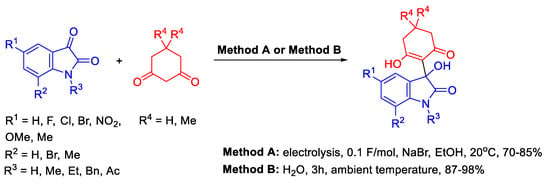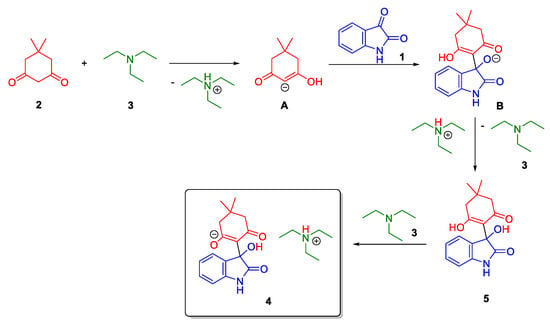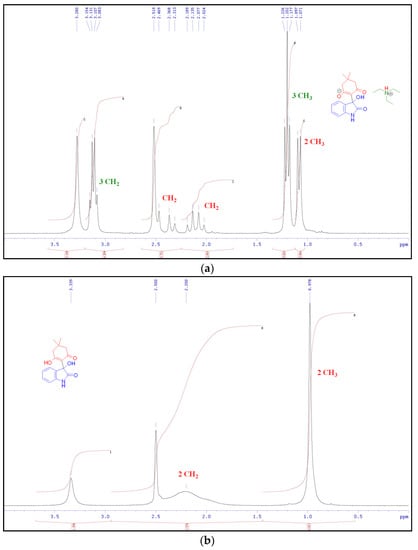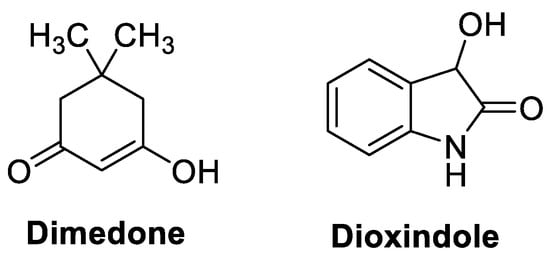Abstract
In recent years, the application of privileged structures has become a powerful approach in the discovery of new biologically active molecules. Ion pairing is a strategy used to enhance the permeation of ionized topical drugs. A convenient and efficient method for the synthesis of triethylammonium 2-(3-hydroxy-2-oxoindolin-3-yl)-5,5-dimethyl-3-oxocyclohex-1-en-1-olate has been developed. The presented protocol includes an aldol reaction and the formation of an ammonium salt. Triethylamine is both a reactant and a catalyst in the process. The structure of the synthesized title compound has been established by 1H, 13C-NMR and IR spectroscopy, mass spectrometry, and elemental analysis.
1. Introduction
Scaffolds are a core concept in medicinal chemistry [1]. The notion of “privileged scaffolds” refers to molecular frameworks that are capable of serving as ligands for multiple targets and/or that occur more often in biologically active molecules [2]. The term “privileged structure” was first introduced in 1988 by Evans et al., who used it to describe repeating, useful structural motifs for discovering new active substances [3,4]. They had noticed that particular chemical structures are able to bind with equal affinity to more than one type of receptor. Following that, an approach for drug design was developed. According to this approach, sensible modifications in these “privileged structures” could lead to the proposal of new potent agonists or antagonists of receptors.
The dimedone moiety is a “privileged scaffold” (acting as a primary pharmacophore) recognizable in many compounds that are useful to treat several diseases, for example tropical infectious diseases [5]. Dimedone and its derivatives exhibited numerous biological properties, including antibacterial [6,7], antifungal [7], and antioxidant [8].
The isatin fragment could be considered as a “privileged scaffold” for the creation of new biologically active compounds [9]. Several types of biological activities could be achieved by substitution in the isatin scaffold, such as anticancer [10], human immunodeficiency virus reverse transcriptase inhibition [11], neuroprotective [12], antifungal [13], and antidiabetic [14] activities.
Ion pairing is a strategy used to increase the permeation of ionized topical drugs [15]. Formation occurs when the electrostatic energy of attraction between oppositely charged ions exceeds their average thermal energy, allowing them to be drawn together and attain a critical distance [16]. The formation of the neutral particle makes it easier to penetrate into a lipid environment.
Taking into account the data mentioned above, the discovery and optimization of dimedone- and isatin-based therapeutic agents have consistently attracted the interest of medicinal chemists, and this goal remains relevant at the moment. Ion pairing is a demanding and useful strategy in medicinal chemistry. As a result, we were inspired to develop the synthesis of the compound with the benefits of isatin and dimedone scaffolds in the form of an ion pair (salt).
2. Results and Discussion
2.1. Synthesis of Triethylammonium 2-(3-Hydroxy-2-oxoindolin-3-yl)-5,5-dimethyl-3-oxocyclohex-1-en-1-olate 4
Previously, our scientific group carried out the synthesis of 3-hydroxy-3-(2-hydroxy-6-oxocyclohex-1-en-1-yl)indolin-2-ones in two ways (Scheme 1). In the first case, the aldol reaction was carried out using electrolysis in alcohol at 20 °C, and the yields were 70–85% [17]. In the second method, the process was implemented in water without any catalyst at room temperature, and the yields varied in the range of 87–98% [18].

Scheme 1.
Synthesis of 3-hydroxy-3-(2-hydroxy-6-oxocyclohex-1-en-1-yl)indolin-2-ones.
In the course of our studies, we have found that if an aldol reaction between isatin 1 and dimedone 2 is carried out in boiling ethanol with an equivalent amount of triethylamine 3, a triethylammonium 2-(3-hydroxy-2-oxoindolin-3-yl)-5,5-dimethyl-3-oxocyclohex-1-en-1-olate 4 is formed (Scheme 2).

Scheme 2.
Synthesis of triethylammonium 2-(3-hydroxy-2-oxoindolin-3-yl)-5,5-dimethyl-3-oxocyclohex-1-en-1-olate 4.
The efficient transformation of isatin (1), dimedone (2), and triethylamine (3) into the previously unknown triethylammonium 2-(3-hydroxy-2-oxoindolin-3-yl)-5,5-dimethyl-3-oxocyclohex-1-en-1-olate (4) was completed in 4 h in EtOH at 78 °C (Scheme 2). The yield of the final compound (4) was 79%. The amine acts as both a reagent and a base catalyst.
The structure of the synthesized compound (4) was confirmed by spectral methods (1H and 13C NMR, IR spectroscopy), mass spectrometry data, and elemental analysis (see Supplementary Materials).
The chemical reaction of isatin and a carbonyl compound in the presence of a base to yield substituted quinoline-4-carboxylic acids is known as the Pfitzinger reaction [19,20]. In our case, not even traces of quinoline were detected in the 1H-NMR spectrum. Apparently, triethylamine is too weak a base for this reaction.
Taking into consideration our previous results [17,18,21,22,23] and aldol reaction data [24], the following mechanism for the transformation of isatin (1), dimedone (2), and triethylamine (3) was proposed, as shown in Scheme 3.

Scheme 3.
Proposed reaction mechanism for the formation of compound 4.
At the first stage, dimedone (2) was deprotonated with triethylamine (3). Then, an aldol condensation occurred between isatin (1) and the cyclic 1,3-diketone anion, A. The resulting anion (B) was first protonated and then deprotonated again to form the final triethylammonium 2-(3-hydroxy-2-oxoindolin-3-yl)-5,5-dimethyl-3-oxocyclohex-1-en-1-olate (4).
2.2. NMR Study of Triethylammonium 2-(3-Hydroxy-2-oxoindolin-3-yl)-5,5-dimethyl-3-oxocyclohex-1-en-1-olate 4 Structure
3-Hydroxy-3-(2-hydroxy-4,4-dimethyl-6-oxocyclohex-1-en-1-yl)indolin-2-one 5 has two hydroxyl groups. Accordingly, any of them can participate in the formation of an ion pair with triethylamine. In order to understand which hydroxyl group became an anion, we compared the 1H-NMR spectra of compounds 4 and 5 (Figure 1).

Figure 1.
Representative fragments of 1H-NMR spectra showing changes during the formation of an ion pair for: (a) triethylammonium 2-(3-hydroxy-2-oxoindolin-3-yl)-5,5-dimethyl-3-oxocyclohex-1-en-1-olate, 4; (b) 3-hydroxy-3-(2-hydroxy-4,4-dimethyl-6-oxocyclohex-1-en-1-yl)indolin-2-one, 5.
In the case of compound 5, the methyl groups appear on the spectrum as a single signal (singlet) and the methylene fragments as a wide multiplet (Figure 1b). This is due to the free rotation of the dimedone moiety and keto-enol tautomerism.
If the formation of an ion pair occurs with the participation of the hydroxyl group of the dimedone fragment, the signals of the protons of the methyl groups look like separate singlets, and the signals of the protons of the methyl groups look like doublets (Figure 1a). This is due to the fact that tautomerism becomes impossible. There is one set of signals on 1H- and 13C-NMR spectra (see Supplementary Materials); therefore, there is one form of triethylammonium salt in solution.
The conclusions drawn from the comparison of the 1H-NMR spectra are also confirmed by the pKa values. The pKa value of dimedone (Figure 2) is known; it is 5.23 [25]. Unfortunately, the pKa values for dioxindole (Figure 2) or similar compounds were not known in the literature. However, SciFinder [26] gives a value of 11, calculated on the basis of the software from the ACD/Labs software package [27]. Accordingly, the hydroxyl group of dimedone has a higher acidity.

Figure 2.
Separate fragments constituting the anionic part of compound 4.
Thus, it can be concluded that the hydroxyl group of the dimedone fragment was involved in the formation of the ion pair in compound 4.
3. Materials and Methods
3.1. General Methods
All of the solvents and chemicals were easily obtained from commercial sources, and they were all used without further purification.
The melting point was determined using the Gallenkamp melting-point apparatus (Gallenkamp & Co., Ltd., London, UK). 1H and 13C NMR spectra were recorded with a Bruker AM300 spectrometer (Bruker Corporation, Billerica, MA, USA) at ambient temperature in a DMSO-d6 solution. The IR spectrum (KBr pellets) was obtained by a Bruker ALPHA-T FT-IR spectrometer (Bruker Corporation, Billerica, MA, USA). The mass spectrum (EI = 70 eV) was registered on a Kratos MS-30 spectrometer (Kratos Analytical Ltd., Manchester, UK). Elemental analyzer 2400 (Perkin Elmer Inc., Waltham, MA, USA) was used for elemental analysis.
3.2. Synthesis of Triethylammonium 2-(3-Hydroxy-2-oxoindolin-3-yl)-5,5-dimethyl-3-oxocyclohex-1-en-1-olate 4
Isatin (1) (0.441 g, 3 mmol), dimedone (2) (0.420 g, 3 mmol), and triethylamine (3) (0.303 g, 3 mmol) were refluxed in 10 mL of EtOH for 4 h. After the reaction was finished, the precipitate was filtered, washed with well-chilled ethanol (4 mL × 2), and dried to isolate the pure triethylammonium 2-(3-hydroxy-2-oxoindolin-3-yl)-5,5-dimethyl-3-oxocyclohex-1-en-1-olate 4.
Triethylammonium 2-(3-hydroxy-2-oxoindolin-3-yl)-5,5-dimethyl-3-oxocyclohex-1-en-1-olate (4). Yellowish powder; yield 79% (0.918 g); mp = 297–298 °C (decomp.) (from EtOH); FTIR (KBr) cm−1: 3272 (O-H), 3182 (N-H), 2963 (CH2-N), 2639 (NH+), 2498 (NH+), 1721 (C=O), 1578 (C=C Ar), 1521 (C=C Ar), 1485 (CH2), 1441 (CH3), 1390 (CH3), 1357 (C(CH3)2), 1153 (C-N), 1063 (C-O), 760 (C=C dim.). 1H NMR (300 MHz, DMSO-d6): δ 1.07 (s, 3H, CH3 dim.), 1.10 (s, 3H, CH3 dim.), 1.20 (t, 3J = 7.2 Hz, 9H, 3 CH3 amine), 2.05 (d, 2J = 16.1 Hz, 1H, CH2 amine), 2.16 (d, 2J = 16.1 Hz, 1H, CH2 dim.), 2.34 (d, 2J = 16.5 Hz, 1H, CH2 dim.), 2.49 (d, 2J = 16.5 Hz, 1H, CH2 dim.), 3.12 (q, 3J = 7.2 Hz, 6H, 3 CH2 amine), 6.78–7.22 (m, 3H, 3 CH Ar), 7.13 (t, 3J = 7.4 Hz, 1H, CH Ar), 8.38–9.22 (br s, 1H, HN+), 9.41 (s, 1H, NH), 9.51 (s, 1H, OH isatin) ppm; 13C NMR (75 MHz, DMSO-d6): δ 8.6 (3C, 3 CH3 amine), 26.5 (CH3 dim.), 29.0 (CH3 dim.), 31.9 (C(CH3)2), 40.7 (CH2 dim.), 45.8 (3C, 3 CH2 amine), 50.5 (CH2 dim.), 78.5 (C(3)-OH), 103.4 (C(2′)=C(1′)-O−), 115.3 (C(7)H Ar), 120.7 (C(4)H Ar), 123.1 (C(5)H Ar), 126.7 (C(6)H Ar), 127.5 (C(3a)), 135.2 (C(7a)), 152.0 (C(2)=O), 180.3 (C(1′)-O−), 191.9 (C(3′)=O) ppm; MS (m/z, relative intensity %): 286 [C16H16NO4]+ (1), 271 [C16H16NO4 − CH3]+ (24), 140 [C8H12O2 dimedone]+ (5), 101 [Et3N]+ (18), 86 [Et3N − CH3]+ (100), 27 [C2H3]+ (65); Anal. calcd. for C22H32N2O4: C, 68.01; H, 8.30; N, 7.21%; found: C, 68.45; H, 8.36; N, 7.12%.
4. Conclusions
In summary, a convenient and efficient reaction for the preparation of triethylammonium 2-(3-hydroxy-2-oxoindolin-3-yl)-5,5-dimethyl-3-oxocyclohex-1-en-1-olate was carried out. The proposed method is based on the reaction of isatin, dimedone, and triethylamine. The process includes an aldol reaction and the formation of an ammonium salt. In addition, the amine is both a reactant and a catalyst. Easily available starting chemicals and a simple work-up process are advantages of this approach. The structure of the obtained compound was confirmed by 1H, 13C-NMR, IR spectroscopy, mass spectrometry with electron impact ionization (EI-MS), and elemental analysis.
Supplementary Materials
The following are available online. Compound 5 spectra: 1H NMR (Figure S1), 13C NMR (Figure S2), IR (Figure S3), MS (EI) (Figure S4).
Author Contributions
Conceptualization, Y.E.R. and M.N.E.; methodology, Y.E.R. and M.N.E.; validation, Y.E.R. and F.V.R.; investigation, Y.E.R.; resources, M.N.E.; data curation, F.V.R.; writing—original draft preparation, Y.E.R. and F.V.R.; writing—review and editing, M.N.E.; visualization, Y.E.R.; supervision, M.N.E. All authors have read and agreed to the published version of the manuscript.
Funding
This research received no external funding.
Institutional Review Board Statement
Not applicable.
Informed Consent Statement
Not applicable.
Data Availability Statement
The data for the compound presented in this study are available in the Supplementary Materials of this article.
Conflicts of Interest
The authors declare no conflict of interest.
Sample Availability
Samples of the compounds 4 and 5 are available from the authors.
References
- Zdrazil, B.; Guha, R. The Rise and Fall of a Scaffold: A Trend Analysis of Scaffolds in the Medicinal Chemistry Literature. J. Med. Chem. 2018, 61, 4688–4703. [Google Scholar] [CrossRef] [PubMed]
- Zhao, H.; Dietrich, J. Privileged scaffolds in lead generation. Expert Opin. Drug Discov. 2015, 10, 781–790. [Google Scholar] [CrossRef] [PubMed]
- Evans, B.E.; Rittle, K.E.; Bock, M.G.; DiPardo, R.M.; Freidinger, R.M.; Whitter, W.L.; Lundell, G.F.; Veber, D.F.; Anderson, P.S.; Chang, R.S.L.; et al. Methods for drug discovery: Development of potent, selective, orally effective cholecystokinin antagonists. J. Med. Chem. 1988, 31, 2235–2246. [Google Scholar] [CrossRef] [PubMed]
- Skoreński, M.; Sieńczyk, M. The Fellowship of Privileged Scaffolds—One Structure to Inhibit Them All. Pharmaceuticals 2021, 14, 1164. [Google Scholar] [CrossRef] [PubMed]
- Mohareb, R.M.; Abouzied, A.S.; Abbas, N.S. Synthesis and Biological Evaluation of Novel 4,5,6,7-Tetrahydrobenzo[D]-Thiazol-2-Yl Derivatives Derived from Dimedone with Anti-Tumor, C-Met, Tyrosine Kinase and Pim-1 Inhibitions. Anticancer Agents Med. Chem. 2019, 19, 1438–1453. [Google Scholar] [CrossRef]
- Rao, T.N.; Krishnarao, N.; Ahmed, F.; Alomar, S.Y.; Albalawi, F.; Mani, P.; Aljaafari, A.; Parvatamma, B.; Arshi, N.; Kumar, S. One-Pot Synthesis of 7,7-Dimethyl-4-Phenyl-2-Thioxo-2,3,4,6,7,8-Hexahydro-1H-Quinazoline-5-OnesUsing Zinc Ferrite Nanocatalyst and Its Bio Evaluation. Catalysts 2021, 11, 431. [Google Scholar] [CrossRef]
- Barakat, A.; Al-Majid, A.M.; Al-Qahtany, B.M.; Ali, M.; Teleb, M.; Al-Agamy, M.H.; Naz, S.; Ul-Haq, Z. Synthesis, antimicrobial activity, pharmacophore modeling and molecular docking studies of new pyrazole-dimedone hybrid architectures. Chem. Central J. 2018, 12, 29. [Google Scholar] [CrossRef]
- Maharvi, G.M.; Ali, S.; Riaz, N.; Afza, N.; Malik, A.; Ashraf, M.; Iqbal, L.; Lateef, M. Mild and efficient synthesis of new tetraketones as lipoxygenase inhibitors and antioxidants. J. Enzyme Inhib. Med. Chem. 2008, 23, 62–69. [Google Scholar] [CrossRef]
- Melis, C.; Meleddu, R.; Angeli, A.; Distinto, S.; Bianco, G.; Capasso, C.; Cottiglia, F.; Angius, R.; Supuran, C.T.; Maccioni, E. Isatin: A privileged scaffold for the design of carbonic anhydrase inhibitors. J. Enzyme Inhib. Med. Chem. 2017, 32, 68–73. [Google Scholar] [CrossRef]
- Hou, J.; Jin, K.; Li, J.; Jiang, Y.; Li, X.; Wang, X.; Huang, Y.; Zhang, Y.; Xu, W. LJNK, an indoline-2,3-dione-based aminopeptidase N inhibitor with promising antitumor potency. Anti Cancer Drugs 2016, 27, 496–507. [Google Scholar] [CrossRef]
- Corona, A.; Meleddu, R.; Esposito, F.; Distinto, S.; Bianco, G.; Masaoka, T.; Maccioni, E.; Menéndez-Arias, L.; Alcaro, S.; Le Grice, S.F.; et al. Ribonuclease H/DNA Polymerase HIV-1 Reverse Transcriptase Dual Inhibitor: Mechanistic Studies on the Allosteric Mode of Action of Isatin-Based Compound RMNC6. PLoS ONE 2016, 11, e0147225. [Google Scholar] [CrossRef] [PubMed]
- Tavari, M.; Malana, S.F.; Joubert, J. Design, synthesis, biological evaluation and docking studies of sulfonyl isatin derivatives as monoamine oxidase and caspase-3 inhibitors. Med. Chem. Commun. 2016, 7, 1628–1639. [Google Scholar] [CrossRef]
- Akdemir, A.; Güzel-Akdemir, Ö.; Karalı, N.; Supuran, C.T. Isatin analogs as novel inhibitors of Candida spp. β-carbonic anhydrase enzymes. Bioorg. Med. Chem. 2016, 24, 1648–1652. [Google Scholar] [CrossRef] [PubMed]
- Wang, G.; Peng, Z.; He, D.; Yan, C.; Liu, W. Coumarin-Isatin Type Compound Useful in Treatment of Diabetes Mellitus and Its Preparation. Patent CN105237521A, 2016. Available online: https://patents.google.com/patent/CN105237521A/zh (accessed on 19 January 2023).
- Cristofoli, M.; Kung, C.-P.; Hadgraft, J.; Lane, M.E.; Sil, B.C. Ion Pairs for Transdermal and Dermal Drug Delivery: A Review. Pharmaceutics 2021, 13, 909. [Google Scholar] [CrossRef] [PubMed]
- McNaught, A.D.; Wilkinson, A. IUPAC. Compendium of Chemical Terminology, 2nd ed.; Blackwell Scientific Publications: Oxford, UK, 1997; Available online: https://goldbook.iupac.org (accessed on 19 January 2023).
- Elinson, M.N.; Merkulova, V.M.; Ilovaisky, A.I.; Chizhov, A.O.; Belyakov, P.A.; Barba, F.; Batanero, B. Electrochemically induced aldol reaction of cyclic 1,3-diketones with isatins. Electrochim. Acta 2010, 55, 2129–2133. [Google Scholar] [CrossRef]
- Elinson, M.N.; Ryzhkova, Y.E.; Kalashnikova, V.M.; Egorov, M.P. Noncatalytic on water aldol reaction of isatins with cyclic 1,3-diketones at room temperature without the need for subsequent chromatography. Mendeleev Commun. 2022, 32, 543–545. [Google Scholar] [CrossRef]
- Pfitzinger, W. Chinolinderivate aus Isatinsäure. J. Prakt. Chem. 1886, 33, 100. [Google Scholar] [CrossRef]
- Lv, Q.; Fang, L.; Wang, P.; Lu, C.; Yan, F. A simple one-pot synthesis of quinoline-4-carboxylic acid derivatives by Pfitzinger reaction of isatin with ketones in water. Monatsh. Chem. 2013, 144, 391–394. [Google Scholar] [CrossRef]
- Ryzhkova, Y.E.; Fakhrutdinov, A.N.; Elinson, M.N. Ammonium Salts of 5-(3-Chromenyl)-5H-chromeno[2,3-b]pyridines. Molbank 2021, 2021, M1219. [Google Scholar] [CrossRef]
- Elinson, M.N.; Vereshchagin, A.N.; Ryzhkova, Y.E.; Karpenko, K.A.; Ushakov, I.E.; Goloveshkin, A.S. Direct four-component assembling of arylaldehydes, dimethylbarbituric acid, 4-hydroxycoumarine, and cyclic amines into complex scaffolds with three different heterocyclic rings. Monatsh. Chem. 2021, 152, 1327–1336. [Google Scholar] [CrossRef]
- Elinson, M.N.; Vereshchagin, A.N.; Ryzhkova, Y.E.; Karpenko, K.A.; Ushakov, I.E.; Maslov, O.I.; Egorov, M.P. Four-component transformation of benzaldehydes, dimethylbarbituric acid, 4-hydroxy-6-methyl-2H-pyran-2-one, and morpholine into the unsymmetrical ionic scaffold with three different heterocyclic rings. Russ. Chem. Bull. 2022, 71, 464–473. [Google Scholar] [CrossRef]
- Mandal, S.; Mandal, S.; Ghosh, S.K.; Ghosh, A.; Saha, R.; Banerjee, S.; Saha, B. Review of the aldol reaction. Synth. Commun. 2016, 46, 1327–1342. [Google Scholar] [CrossRef]
- Bell, R.P.; Higginson, W.C.E. The catalysed dehydration of acetaldehyde hydrate and the effect of structure on the velocity of protolytic reactions. Proc. Roy. Soc. 1949, A197, 141–159. [Google Scholar] [CrossRef]
- SciFinderⁿ—Chemical Compound Database, American Chemical Society. Available online: https://scifinder.cas.org (accessed on 10 February 2023).
- ACD/ChemSketch, version 2021.1.2; Advanced Chemistry Development, Inc. (ACD/Labs): Toronto, ON, Canada, 2021; Available online: https://www.acdlabs.com (accessed on 10 February 2023).
Disclaimer/Publisher’s Note: The statements, opinions and data contained in all publications are solely those of the individual author(s) and contributor(s) and not of MDPI and/or the editor(s). MDPI and/or the editor(s) disclaim responsibility for any injury to people or property resulting from any ideas, methods, instructions or products referred to in the content. |
© 2023 by the authors. Licensee MDPI, Basel, Switzerland. This article is an open access article distributed under the terms and conditions of the Creative Commons Attribution (CC BY) license (https://creativecommons.org/licenses/by/4.0/).